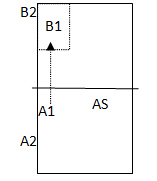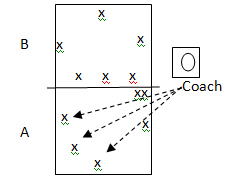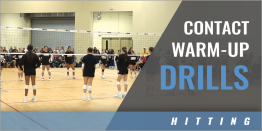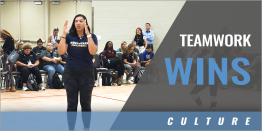|
By: Julie Kaiser - AVCA Member - Previously Head Coach at Vista High School (Vista, CA) For some athletes, competitiveness is in their blood. For others, competition is the necessary evil of the sport at which they enjoy or even excel naturally. As coaches, it is in our best interest to develop all of our athletes' willingness and acceptance of competition in our game. It is key to individual and team success. The challenge is how do we incorporate competition regularly in our practices beyond scrimmaging at the end of the day? This article will provide you with the tools necessary to create and incorporate competition during a productive team practice. Coaches can customize competitions within their practices according to the team's needs and abilities. Several drills are provided for immediate implementation. COMPETITION, by definition, is a contest for honor, advantage, or prize. In basic terms, in the world of volleyball, honor can come with a conference championship. A trophy received at a tournament is a great example of the prize in competition. Finally, having a winning record in your league provides you a seeding advantage going into conference playoffs. Competition in and of itself is the process to an end, with the end being either winning or other specified goal. The most obvious benefit to competition in practice is to help your players be more comfortable with the 'real' games. Butterflies, nervous stomach, and the "jitters" are all physical reactions to upcoming competition. Proper planning and preparation will diminish these uneasy reactions. But do we as coaches do enough for our players mentally to improve their comfort level in the face of competition? Another and less realized benefit of competition in practice is to force change in your team or athlete. An accomplished angle-hitting player who is hesitant to hit line shots finds his or her fortitude to force change within themselves if the team's success is based solely on line hits. The third benefit of competition and perhaps most beneficial to coaching in practice, is the reduction of verbal repetition. A middle hitter who fails to transition behind the attack line consistently will be more conscious of their movement if the team's success in competition is based on his or her making a clean transition off the net. This situation can eliminate the monotony and sometimes constant nagging of the coach reminding the athlete to complete transitions in the heat of, or after plays. There are four major factors necessary to create a productive competition in practice. These factors include (1) identifying the competitive format, (2) selecting the appropriate measure or goal, (3) choosing the appropriate drill, and (4) leveling the playing field of athletes. Competitive Format The three basic formats of competition that exists in practice are:
Measurement or Goal All measurements are made based on either quality and/or quantity. Samples in a practice setting would be:
Converting Drills into Competition
Leveling the Playing Field Adjustments must be made in creating fair and competitive drills. Some considerations that will help in evening up the court in team play are to pit your top hitter against the top digger, splitting the top hitters, giving the better hitter the lesser setter. Once the top four players are divided into two groups, the rest of the team can normally be assigned either side. Prior to starting a competition, physically look at your set up of players (I.E. hitters/blockers, hitters/defense, passers/serve). Ensure that the competition is set up as fairly as possible. Recording and Rewarding Charting Success Using basic spreadsheet charting, track each athlete's success either individually or as part of each team on which the athlete is assigned. Success is recorded with goal that is met. Coaches can use any variety of icons for charting: Stickers, smiley face drawings, stars, or just checkmarks. Immediately following each competition, winners chart themselves. Penalty for the losers is to shag balls, 10 and 10, running lines, taking down nets, or any other activity the coach designates. Since some players will establish a significant lead in practice competition, charting needs an ending which should take place halfway and at the end of the season. Once you bring a chart to the end, the top athletes (I suggest top 25% of the team)can be rewarded with a variety of 'prizes' from shortened practices, to special privileges, to coffee shop gift cards and the like. Starting a new charting at mid-season provides a fresh, even recharging start for your athletes. Although competitions within practices may not be the cure-all for game days, it will give your players the opportunity to realize that commitment and effort is the only path toward a goal for the individual as well as the team.
COMPETITION FOR THE INDIVIDUAL Serve Receive Passing Drill Rate player's pass average (0-3). Maintain chart (see attached) for progress evaluation. This can also be done in conjunction with the Servers vs. Passers competition. Timed Sprints Sideline touches or any other sprint that includes lateral movement. Maintain chart for progress evaluation and improvement. Athletic measurement Approach jump, block jump, etc. Focus is on improvement. Stats During Play During practice games or scrimmages, keep digging or passing stats. Game Stats Maintain individual stat page for self evaluation. Ultimate Winner Competition Team lines up to hit a 4 from coach's toss. If a hit is 'not good', that hitter becomes defense on the other side. As game progresses, when a defender recovers a ball and sends back to the hitter side, the current hitter and last hitter play doubles against the defense side. If the hitting side loses, the player at fault must join the defense and play continues. After time, all but one hitter should be on the defensive side. If the hitter gets a kill, he/she is the Ultimate Winner. If defense returns the ball, the hitter and coach must work to defend and win the rally, and if they win, that hitter is the Ultimate Winner. If the hitting side loses, there is no UW. Jogging Serves Set team goal (IE 12 serves in a row, 24 serves in a row). You can designate a location or just work on getting serves in the court depending on level of ability. Team jogs around court as each player is directed to serve. If the designated number/location is not met the first time, repeat the drill as necessary (IE start over). Once the team goal is met, the individual with 'flawless' serving is rewarded ACE to Replace M&M Passing Individual sits at target (setter's spot) on chair eating bag of m&m's. One at a time, players practice passing a ball to target. If they hit the player/chair, they get to sit in the chair and eat m&m's until they are struck by a passed ball. 4 Square Just like regular 4 Square play with a "queen" spot. Only 3 hits per side. Play is initiated by the athlete in the lowest ranking quadrant. Athletes may send ball across net or to the side quadrant, trying to eliminate a player. Ball must always be at its highest peak, high enough to clear the net after each contact. Players may work together to gain a higher status, but there is only one "queen". 2's and 3's COMPETITION Pepper Drills Your team plays a designated Pepper (IE 2-man, 3-man, etc.). If the ball hits the ground at any time or is caught, that pair/trio must sit down (they are 'out'). The last pair/trio left playing Pepper is rewarded. Pairs or 3s Queens Set teams. Each team can only gain points while on the 'Queen' side. After a designated amount of time, the highest score is rewarded. Pairs or 3s Tournament Teams are established by coach. Best attacker, best digger, and best all-around should not be on the same team. Timed game play at 5 minutes. At end of timed play, tally those teams that won. Rotate teams to play others and tally only those with wins. Variation for the individual – Pairs (3s) are made randomly for each 5 minute game. When each game ends, tally only the winning players. At the end of several plays, the athlete with the most wins, wins. Stratego - aka Octopus Drill Players stay in teams of 3. Coach initiated rally, 6 on 6. When a side wins (see diagram), that side of the court moves forward, and the losing side moves backward. The back row of the losing team moves off the court. The team that is 'off' moves into the back row of the winning side. Play continues. Scoring: Each time a team of 3 crosses under the net, they gain a point.
4's, 5's, 6's, AND OTHER COMPETITIONS Skill Drills How long does it take your team to serve 25 balls over the net? Establish that answer and use it as the team goal to beat next time. How many balls are used to serve 25 'good' serves? 35? Next time give them 34 balls with a consequence if they do not succeed (IE. If you get 25 serves in using only 34 balls, we'll get out 5 min. early, or we'll play your game of choice the final 10 minutes of practice). How many serves in a row can your team accomplish one player at a time? Ball Collection Race Two teams of 5 or more, each player with a ball. Teams are in single file line at the baseline. At whistle, first man of each team runs with ball to opposite baseline and back, hands his ball to second man (who now has 2 balls). Second man runs to opposite baseline and back, handing his 2 balls to third man who repeats the run with 3 balls. Relay race continues until the last man completes his run carrying all the team balls. Best of three. Serve or Die Relay race of 2 equal teams on opposite sides of the net. Team with most points wins: Teams are lined up across the baseline, each player with a ball. At whistle, player 1 runs to the attack line, back to baseline, to the net, and back to baseline. She then attempts a serve. Player 2 begins her run when player 1 touches the baseline the first time (after touching the attack line) and repeats the same run. Player 3 begins her run when player 2 touches the baseline the first time, and so forth. A point is awarded with each successful serve. A point is deducted for each failed serve. A point is awarded to the team that finishes first. Best of 3 wins. 6 v. 3 Game Team of 6 must earn 10 points before team of three earns 5 points. Teams of three can be rewarded for success. Compensation* Three players are on side A and six players are on side B. The coach initiates the ball to side A with either a free ball toss or an attack, setting the intensity of the drill by the difficulty of the initial ball. The drill ends when side A scores seven points against side B, with the last two points scored back to back. Any player on side A can score and they can attack from anywhere along the net. If any player on either side does not make an effort to play ball, side A goes to 0. This ensures that side A player its heart out and side B does not go easy on side A. Net Joust with Defenders 2 players joust with coverage. Point earned only if ball is killed in joust. Defenders work to 'up' the ball and deny the point. Any ball 'upped' ends the kill opportunity and another ball is initiated in the joust. Servers v. Passers Two equal teams. Three ways to earn points. Points only earned by servers if serve is an Ace. Points only earned by passers if pass results as a 3 option pass. A Umissed serveU results in a point for the passing side. After serving 5 balls each, the servers become the passers, and vice versa. ? Hitters v. Diggers I Team is split in half. Hitters (in a hitting line) are given 3 balls (or other designated amount) each to attack. Points are only earned by hitters on the hitting side with a kill. Once all hitters have attacked 3 balls, Teams switch. Hitters become the diggers, and vice versa. Highest score after both sides have hit wins. Blockers can be used. Up to 6v.6 Hitters v. Diggers II Teams split in half, each with a setter. Team A v. Team B, pairing up is encouraged to engage players in strategy. Each player from team A hits 4s down the line within a 10wide x 15deep area to their 'matched' player from team B. Kill is a point for team A, playable dig is a point for team B. Missed hit is a wash and must be played again after all players on team A has had a chance to hit. After each play has ended in a point, Team B hits against team A with the same pairings. See diagram:
5 v. 5 Dig or Die Two pin hitters and three back row defenders on both sides. Designate a setter. Blocking is permitted. Coach initiated drill. Rally score to 25. If, at any time the ball hits the floor without effort to dig, that team loses ALL of their points. Touch and Go, 5 in a Row Teams of 4. One team on the court at a time. Others are shagging or initiating balls. Goal is to pass, set, attack successfully 5 times in a row. How it works: Ball is initiated. As each player contacts the ball, he/she must run and touch the back wall (or designated location) and return to the court to continue play. As soon as the first ball is attacked, the next ball is sent into the court and played out the same way. If an error occurs, that team is tossed off the court and a new set of 4 starts with their first ball. First team of 4 that gets 5 pass/set/attacks in a row ends the game and is rewarded. Note- If your players total is not divisible by 4, you can still run the competition. Players just don't have the same team members every time. Digger in the Hole A Julie exclusive! Your team's level of skill will determine whether or not you can use this drill for competition. Points are only scored on the initial attack. Pin blockers must block line, leaving the MBack position open to the hitter. Points are earned by the middle back digger with a playable dig on the FIRST hit. Team A is set up with a middle back digger. Team B must use pin hitters to hit AT the middle back digger (as in hitting seam). If the MBack digs the ball playable, Side A gets a point and the teams play out the rally. Side B must successfully hit 10 balls to the digger's area (which can be marked by cones). If Side B hits a ball to the MBack area and it is NOT dug, then Side B gets the point. After the 10 balls are completed the score itself should add up to 10. Then Side A and B switch roles for the next 10 hits. FULL ON SCRIMMAGE GAMES Forced Hit Rally Score Equal teams on both sides of the net. Pin hitters are told they must hit specific shots (IE line, angle). The defending side must block the opposite shot, helping to force the hitter to hit the designated location. Rally score, coach initiated. Game plays out. Points UonlyU scored with correct shots that are kills. Winning team is rewarded. M v. M Or L v. L, etc. With conditions! Rally score is based solely on UMH kill or block killU. PLUS, extra point given for MH Ufull transitionU behind attack line, extra point given for Uclosing the blockU only. This scoring technique is a bit challenging at first but you'll soon develop a pattern for watching for these moves quickly. You can create your own conditions as you deem a need (IE L v. L, transition outside the court, transition to appropriate defensive position, etc. 3's Serve Receive 6 v. 6- Serve receive must win 3 rallies out of 5 serves in order to rotate. If the serving team wins 3 of 5, they rotate. First team to rotate all 6 rotations wins. Be sure to switch sides and repeat play. Scrimmage - Progressive Scoring 6 v. 6 regular side out play. During play, each time the ball crosses the net, a point is tallied. For example, Side A serves. Point tallied for ball crossing net. Side B plays the ball back to side A. 2nd point tallied for ball crossing net. Ball drops in the court on Side A's floor. Side B wins the rally and is awarded the 2 points. Keep in mind that when a ball is attacked at the net (crosses the net), then is blocked (crossing the net again), 2 tally points have just occurred. The longer the rally, the more points tallied and at stake causing anxiety to win the rally without making a critical error. Play to 50 points. Positional Points Each side can only score with particular play kill (IE slide, bic, RS hitter, etc.) Teams can have same assignment or different (IE Side A earn points only on a slide kill while Side B can only earn points on the MH hitting a 3). Bingo 6 v. 6 side out with Bingo sheet (see chart). Bongo Scoring: The starting team must win 3 rallies in a row to get a 'Bongo' and rotate. First team to rotate all 6 rotations wins. Ball is initiated on side A. Team A is in a defensive position as if defending the outside attack. Coach gives driven ball to OH-A and the teams play out the rally. If team A wins, then the LB-A defender receives a driven ball from coach and play repeats. If team A wins again, the Mback-A receives the driven ball and play resumes. If team A wins that third rally, they yell "BONGO!" and rotate. If at any time team A did not win the rally, then team B gets into defensive position to receive driven ball from coach, and attempts to win 3 rallies to get their Bongo. (Note-If at any time it 'ain't working, just rotate one and continue.
Baseball (simplified) Scoring: Only the serving team can score points. With each serve, team A must win a total of 4 rallies (first base, second base, third base, home) BEFORE team B wins 3 (Outs). Team A only gains a point with each 4 bases acquired. Once team B has forced team A into 3 outs, team B serves, trying to gain bases (winning rallies) before they have 3 outs (lose 3 rallies to team A). Once team B has gotten their 3 outs, that is the end of the first inning and both teams rotate. Game continues until all 6 rotations have completed play. Momentum Mover* Sides A and B both consist of six players in normal rotation. The number of points gained after each rally varies depending on the momentum built. Side A serves. If side A wins the rally, they do not get a point, but instead receive a tossed ball from the coach. If side A wins the rally on the tossed ball, they get one point and another tossed ball. If side A wins the second tossed ball, add two more points to the score and they get another tossed ball. Winning the third tossed ball gains side A 3 more points. Each consecutive tossed ball is worth one more point than the previous one. Once side B stops side A, side B serves for the chance to win the rally and receive tosses. The actual served ball is never worth a point, just the opportunity to receive tosses. Once a serve takes place, the first tossed ball is worth one point again. Teams rotate every time they win the serve, just like a normal volleyball game. WHOLE TEAM GOAL COMPETITION Rally Control 4s or more. Controlled pass, set, and hit. Goal is to have the ball cross the net a set number of times (10-15) with players making 3 set contacts of a pass, set, attack, then rotating clockwise as the ball crosses over the net to the other side. Play repeats from the other side. If the ball goes out of play (drops, shanks, not attacked), Immediately begin a new rally. Once a number of crossovers have been accomplished, that number plus 1 is the team's goal next time. Note-If your team ability to attack every 3rd contact is too high an expectation, accepting a free ball to keep the rally alive is permissible. Perfect Pass 21 Serve receive practice. At the setter target area a 2x2 square is taped onto the floor. When passing, a pass to this location is a perfect pass. Team A serves to Team B. Team B passes, rotating passers in with every serve. Passer goes to target after passing a ball. Only passed balls that are caught overhead by the target player while in the box counts as a perfect pass. A point is deducted for every shanked ball. Team B must make 21 perfect passes to finish. Then Team A receives serves from Team B repeating the drill. CHARTS (PDF): Volleyball Bingo – Click here - Can adjust spaces according to your team's needs. I.E. MH = 3 full transitions behind attack line, MH closes block 2 times in a rally, or Sally Setter gets a dump kill. Smiley Chart - Click here - Award chart for individual or team success in competition in practice. Progression Chart – Click here - As measured in practice. If rewards are used, must include ALL players.
About the Author... Julie Kaiser was previously the head volleyball coach at Vista (CA) High School. She also served in the same capacity for the San Diego Volleyball Club. With almost three decades of volleyball experience, Kaiser played at Southern Oregon State College and was a member of the Women's All Armed Forces National Team (US Marine Corps). Her coaching résumé includes being a USA Cap III certified coach, serving as the coach/director of the Athletic Fusion Volleyball Club, and serving as a coaching instructor for the LA '84 Foundation. Julie Kaiser
|









